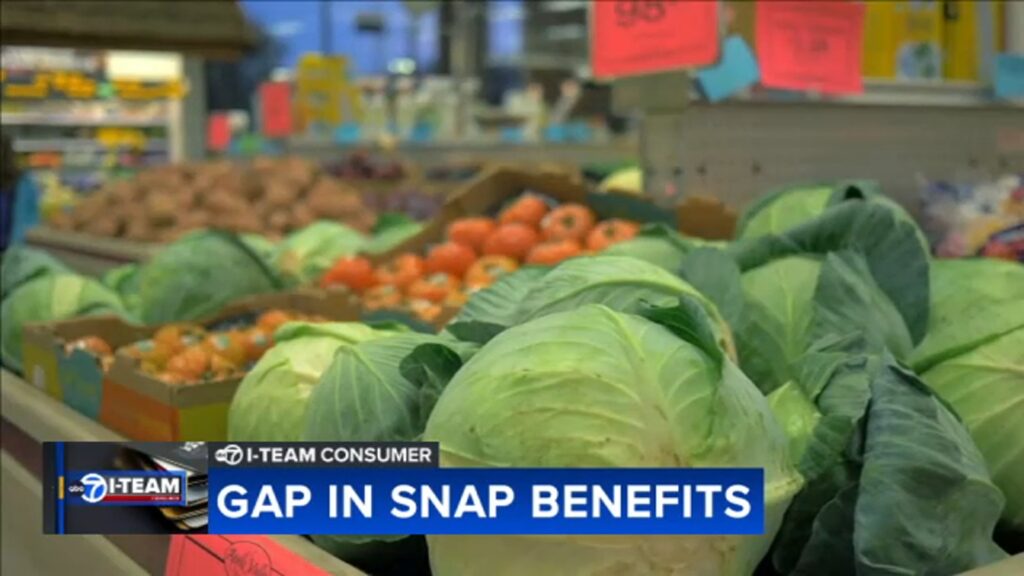CHICAGO (WLS) — People receiving food stamp benefits in Illinois may not be receiving enough to adequately feed their families, according to a report from the Urban Institute research group.
The study revealed a gap between the amount Supplemental Nutrition Assistance Program (SNAP) recipients receive each month and the cost of the average meal. Consumer advocacy groups argue that rising food prices justify an increase in the federal SNAP program, which would benefit the entire country, not just food stamp recipients.
ABC7 Chicago is currently streaming 24/7. Click here to watch
“All I get is Social Security, which isn’t much. Without food benefits I have no food to eat,” June Campbell said.
Campbell is one of about 42 million Americans who rely on SNAP, but she says she’s finding it hard to make ends meet on food stamps these days.
RELATED: Chicago officials warn of SNAP changes starting in March
SNAP benefits are running short, according to a study conducted by the nonpartisan research group Urban Institute: According to data from the institute, the average maximum SNAP benefit for 2023 will be $2.84 per meal, $0.53 less than the average cost of a median-priced meal, which is $3.37.
Elaine Waxman, a senior research fellow at the Urban Institute, said paying out-of-pocket for each meal can quickly become a huge burden for families.
“What this tells us is that while we know the SNAP program is extremely effective at reducing food insecurity, it’s actually underfunded and doesn’t provide enough funding to help people actually put food on the table,” she said.
Read more: Illinois SNAP benefit scammers steal food money from Link cards
Waxman said four in 10 American households rely on SNAP as their only means of purchasing food, and that families would be left in poverty if the benefits were to run out.
“That means they have to develop coping strategies – they buy cheaper, less nutritious but higher calorie options – they have to turn to charity food,” she said. “What’s particularly worrying to us is that we know food insecurity is associated with increased risk of a number of health conditions, including diabetes and high blood pressure.”
In 2021, the USDA updated the Thrifty Meal Plan, which estimates the cost of a healthy meal and is used to determine SNAP benefit amounts. This was the first permanent update to the Thrifty Meal Plan in 45 years.
“In fact, the value of SNAP benefits has increased by about 21 percent. But the statistics I just mentioned show that it’s still not where it needs to be,” Waxman explained.
The Department of Agriculture, which oversees the SNAP program, told the I-Team that significant steps have been taken to increase benefits, saying, “SNAP is the most powerful and widespread tool we have to help low-income people afford healthy foods. USDA’s flagship food assistance program is designed to respond to changing economic conditions, including rising food prices, and help mitigate the impact of inflation on American families.”
SNAP recipients also received a temporary increase in benefits due to COVID-19.
“Food insecurity dropped dramatically during this time, even though many people were temporarily unemployed or faced other financial burdens due to illness,” Waxman said. “So we saw that increased SNAP benefits really made a big difference. Unfortunately, that expired with the end of the pandemic. I understand that it was a temporary benefit, but we learned our lesson.”
Campbell hopes lawmakers and the federal government will work to increase SNAP assistance as she struggles to pay for food.
“When I come in here, I spend $150. I’m the only one. When my husband was alive, $150 would feed me for a month, but not anymore,” she said.
The Urban Institute said SNAP benefits are an issue that everyone should support because without nutritious food, rates of chronic diseases like diabetes and high blood pressure increase, resulting in higher health care costs for everyone.
Rep. Jonathan Jackson, R-Ill., who sits on the Agriculture Committee, said he is actively working to expand SNAP through a bipartisan farm bill. The current farm bill expires in September.
Copyright © 2024 WLS-TV. All rights reserved.


